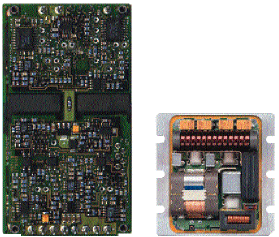Second-generation dc/dc converters:
Integration advancements cut parts count and cost
Improved packaging and technology
also benefits power density,
performance, and design flexibility
of converters
A new line of dc/dc converters has one-third the parts count and is
half the price of its predecessors. The parts benefit from improvements
in silicon integration and use an advanced circuit architecture.
Vicor (Andover, MA) has advanced the state-of-the-art in power technology by introducing its second generation of high-density dc/dc converters. Offered initially in three versions rated 150, 400, and 600 W, the new converters incorporate many of the silicon integration advances previously reserved only for ICs.
Based on the company's zero-current and zero-voltage switching architecture, the converters use one-third the number of parts of their predecessors, thus improving reliability. They have watt-densities of at least 80 W/in. 3 , and can easily be designed into most applications.

By using extensive silicon integration, Vicor's second-generation
dc/dc converters (right) are made using just two IC control circuit elements,
instead of the 288 required in the first-generation converter (left).
In addition, pricing starts at well under $1 per watt–half that of the company's first-generation dc/dc converters and competitive with other converters. The new devices will enable designers to build state-of-the-art power systems with high performance and small size.
The converters represent the first major advance in high-density dc/dc converters, which the company first pioneered in the mid 1980s. The original converters spawned development of several similar high-density products from other power supply makers. With their compact size and relatively high power density, these devices allowed flexible building-block assembly of complete power systems.
However, this first generation of dc/dc converters has lagged behind ICs in silicon fabrication advances. This is partly due to power processing being more complex than signal processing and having traditionally used many discrete components.
Comparing Vicor's first- and second-generation converters clearly illustrates the technology strides. Thephoto shows an example of a second-generation converter, with its two major control elements, next to a first-generation converter that has 288 control components. The first-generation device devotes 60% of the available board real estate for control functions.
In the second-generation converter, the two control circuit elements occupy less than 0.1 in.3 combined, yet provide significantly more functionality than earlier control circuits. The circuits are molded in plastic as separate components, allowing for environmental screening and electrical conditioning well beyond real-world conditions. After being tested, each control circuit is burned in and temperature cycled from –65° to +125°C while being continuously tested over worst-case electrical conditions.
An example of the higher functionality within the second-generation converter is the use of an integrated multiplexed driver that provides extremely short turn-on and turn-off pulses to the high-side power FET. This design reduces the size of the pulse coupling transformer by a factor of 10.
Another factor in the higher functionality is that second-generation converters do not use optical couplers to convey information from the secondary to primary control circuit. Instead, the converters use an integrated, magnetically coupled approach that achieves higher isolation, better temperature stability, and wider bandwidth.
Even output current sensing and current limiting–which in first-generation products involve either a dissipative current shunt or a separate current transformer plus a handful of components–is entirely integrated into silicon in second-generation converters. The only exceptions are a resistor and capacitor, which are used to set the current limit for each particular model.
These converters still use discrete components to set operating parameters including maximum switching frequency, maximum switch-on time, and overtemperature shutdown. This allows the factory to meet the individual requirements of a unique application, such as special input and output voltages, power levels, and temperature ranges.
The converters' patented architecture also makes it possible for the converters to have low conducted noise and output ripple. The converters' maximum operating temperature is 100°C. Moreover, the converters can operate in parallel with fault tolerance and offer programmable outputs. Above-board height is 0.43 in.
Of the three second-generation converters now available, the 150-W model comes in a new micro-sized package. Designated the Model V48C12C150A and priced at $112, the module delivers over 150 W in a package measuring 1.45 x 2.28 x 0.5 in.–yielding a power density of 90 W/in.3
The converter is one-third the size of the company's full-size module. In fact, the entire product is smaller than the space devoted to just the control portion of most first-generation converters.
The other new dc/dc converters are derived from the company's older VI-200 module, which is rated for 200 W and measures 4.6 x 2.2 x 0.5 in. The 400-W converter doubles the output of the VI-200 module and provides a power density of 80 W/in.3
It accepts a 375-Vdc input and provides a 5-V 80-A output with 84% efficiency. The converter is designated Model V375A5C400A and is priced at $180.
The 600-W converter, designated the V375A48C600A and priced at $248, has a 120-W/in.3 density. It also accepts a 375-Vdc input and provides a 48-Vdc output with 90% efficiency. For more information, contact Vicor Express service at 800-735-6200 or e-mail vicorexp@ vicr.com .
–Spencer Chin
Advertisement





